[ 048 ]
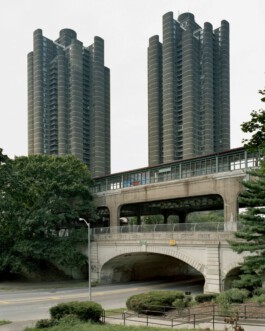
1
Ira Wagner (US),
Superior Apartments
New York City, New York (US)
(1) Please introduce yourself: What is your name, where are you from, what do you do?
I’m Ira Wagner and I live in Montclair, New Jersey about 12 miles west of New York. I worked in banking for many years but decided to stop in 2008 to pursue other interests, including photography. I couldn’t have imagined then that this would lead to me returning to school, and receiving my MFA degree in 2013. Following graduation, I began teaching photography at Monmouth University in New Jersey and I have been working on a number of projects, focused on the urban landscape and the built environment.
(2) What is your relationship with photography and how did you get into it?
Probably like many people, my relationship began when I was young. I delivered the newspaper, saved my 10 and 25 cent tips and bought a camera—a Minolta SRT 100. (It’s quite a workhorse—I still have it and have lent it to students when teaching black and white darkroom at Monmouth). Photography for me is partnered with a life-long interest in maps, travel, urban history, exploring new places and wandering around cities. I must admit, it never occurred to me to pursue photography professionally during my college days, but I think these interests overlapped even then—I studied urban history and planning in college. After leaving banking in 2008, I began to take courses at ICP in New York. Many of these courses had a strong impact on me, particularly on subject matter and developing an approach to photographing. Courses focused on the urban landscape opened up my eyes to a whole different world of landscape photography. I began shooting in and around New Jersey’s meadowlands (places I passed through while commuting to my job in NY) and the neighborhood I grew up in—Yonkers, NY. For some of my first work, I kept shooting in «golden hour,» until one of the ICP teachers said to stop doing that and to shoot in the bleakest, greyest light in the middle of the day. At ICP, I was also exposed to the use of the view camera. Finally, one of my teachers there suggested looking into an MFA, which led to where I am today.
(3) What do you think triggers you to photograph in a certain moment? Is it planned or solely driven by intuition?
Things start with intuition in trying to find the places and scenes that I am interested in and think will make a strong photograph. Then, there is an element of planning as I move into something that I am going to photograph more extensively. The planning includes time of day, type of light, weather and destination. Once in a place at the right time and with the right light, there is again intuition. I’ll generally walk extensively and come to subjects that are what I am looking for. There is always a sense of surprise and discovery in my wanderings, which is part of the pleasure I take in photographing. Also, while driving to my destination, I’ll be alert to places that look ripe for a return visit on a future day.
(4) What is the story you want your pictures to tell?
There are several themes that run through my work; in some projects one of the themes may be stronger than others. Generally, they involve how people choose to live and work. Additionally, I look for layering of history—thinking about the time the places I am photographing were built as well as what has happened since. What were the original designers and builders of a place seeking to communicate? Is the environment conducive to living for them and their families? What does the architecture of the area look like and what messages do their environments convey? How is the history of a place evident in what is there now and how has an environment changed and adapted over time? Why do people choose the place they live? Ultimately, underlying these themes is that there is a common goal for families across history and cultures—for a safe and comfortable place to live.
(5) Which city would you like to visit the most, and why?
I can find something of interest in almost any city I visit. I especially like to explore «everyday» neighborhoods – the places that people live, work, shop and play. I look to find what makes a place unique—the style of buildings, the history, the culture. Earlier this year I made my first visit to India. It was a rich visual environment that appealed to me in so many ways—the layers of history, the passion, energy and vibrancy of the people. One place I didn’t visit which I would like to photograph is Kolkata. It seems like a place with so many layers to explore and photograph. For a photography project, I like to have the opportunity to work in a place over time. As I explore a place, different themes and ideas manifest themselves that I can work on more deeply. Present day Kolkata also combines many things that I have been looking at more recently in the urban environment, including climate change and its effects on the urban and built environment.
(6) Regarding your project Superior Apartments: What was your intention, and how did you come up with the idea?
Superior Apartments combined many interests that I have in the city: the history of urban development, unique architecture, the ideas that have evolved over time for improving the city, and how people impact and are impacted by their environments. There was also the personal relationship I had with the Bronx. I was born there, had family living there through the early 70s, my mother taught school there through the 90s and I worked there in college. The Bronx is essentially a laboratory of urban development. The Grand Concourse (the «Champs Elysees of the Bronx») was built to be the pinnacle of middle class aspirations in the 1920s and 1930s with an explosion of art-deco apartment buildings. In the 1960s and 70s, the Bronx became a catchword for the ills affecting American cities. For many, that image of the Bronx has remained, even as the borough has rebounded and changed. In its history, the Bronx has had dramatic cycles of promise, possibility, loss and revival. In shooting this project, I was looking to capture the range, chaos, richness and beauty of the urban landscape.
(7) Which project did you never finish?
I have several projects that have moved into the background, but which I plan to return to. I have been photographing the Highline in New York City in black and white in a 6x17 format. I have also started a project that goes by the working title Acela, in which I have been photographing the landscape around the train line between New York and Washington. What I find is that I turn to a particular aspect of something that I start and focus in on that. While I have taken pictures in many places along the Amtrak route, including Baltimore and Chester, Pennsylvania, I have focused in for the time being on «twin houses» in Northeast Philadelphia.
(8) What is that «one thing» you have never managed to photograph and is now gone for good?
One of the first areas I explored was the area I grew up in. There are at least two institutions that I would have liked to photograph that are now gone. One is the local candy store—Lane’s Luncheonette. It was a classic New York institution—a lunch counter with stools where you could get an egg cream, racks of magazines and comic books, greeting cards, toys, a pay phone in the back. Everyone came there at some point during the day and they kept tabs which your parents could settle later. The other place that I was surprised to find was gone was the central Yonkers public library. It was one of the Carnegie sponsored libraries and was an inspirational building in the old downtown of the city that I spent hours in. I remember that they had a great collection of architecture monographs. More generally, the life I remember on the sidewalks of Yonkers doesn’t seem to exist there anymore.
(9) If you could travel back / forth in time, what advice would you give your younger / older self?
I would «enlighten» my younger self to the full range of photography and its tools. I would love to have been exposed much earlier to the view camera and all its capabilities.
(10) What do you prefer saying: To «take a photograph» or to «make a photograph», and why?
I still think of it in terms of taking a photograph—looking at the world and extracting something that is interesting to me and may be overlooked.
(11) What is the most interesting experience you have had while photographing?
I’ve had so many. Photography for me is exploration and discovery—finding something unexpected. I particularly like when I am photographing something and someone passing me by turns and looks at where my camera is aimed and tells me that although they pass the site almost every day, they never noticed what I see in the place.
(12) If it wasn’t for photography, what would you be interested in doing instead?
I spent many years already doing things other than photography. I certainly don’t have regrets, but I wouldn’t want to give up the role photography plays in my life today.
(13) How would you describe one of your pictures to a visually impaired person?
A series of 30 story apartment buildings in white and brown brick looms over an expanse of parched lawn making up the bottom third of the frame. The lawn is empty, except for a woman in bright blue sitting on the lawn near the front of the image gazing at the buildings. Her small daughter in pink is facing away, tossing her white sandal in the air. They are dwarfed by the scale of the buildings in the background. The sky is blue grey and filled with high clouds. How does she feel about the place she is living?
(14) What are you currently working on, and—if there is—what is your next project or journey?
In photographing the landscape between New York and Washington, I have come to concentrate on twin houses of Northeast Philadelphia (the neighborhood is also known as «The Great Northeast»). I have been fascinated by the sheer expanse of the landscape—block after block of twin houses with many variations of a basic design—two side by side houses that share a common center wall. Some are of brick, some of stone. The gables may be over individual windows, one side of the houses or the other. Because the structure is shared, they haven’t changed much since the time they were built. The small details are telling—sometimes one side of the lawn is mowed and the other is overgrown with weeds. Many people mark the division by a bush or tree. Some completely hide their side of the building with lush landscaping, others have their lawn chairs and grills out for everyone to see. I see many more trips to the area. I just returned from a vacation to the Adriatic. I loved photographing the architecture there—Trieste, Vicenza and Venice in Italy and Ljubljana in Slovenia. Trieste and Ljubljana have a rich heritage with a strong Austrian Secession influence. Ljubljana has these buildings alongside buildings constructed during the communist era. Vicenza is the home of Palladio who was instrumental in neoclassical architectural design in the 16th Century. Again, many layers of history to explore.
Thank you, Ira.
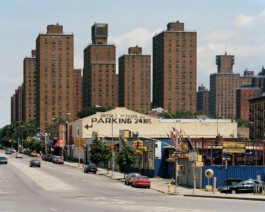
2

3
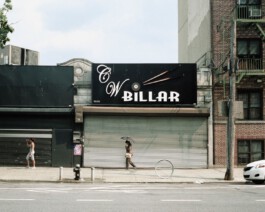
4
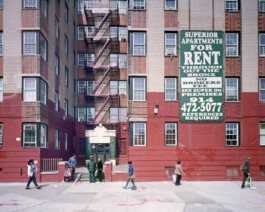
5

6
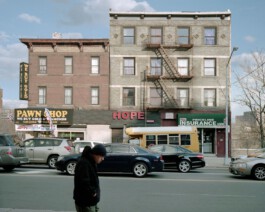
7

8
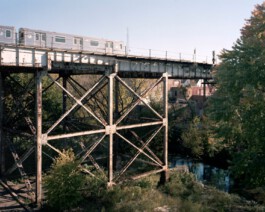
9
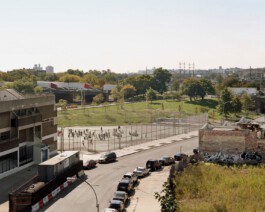
10
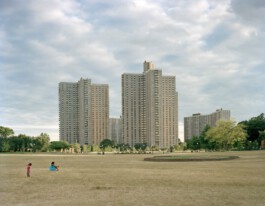
11
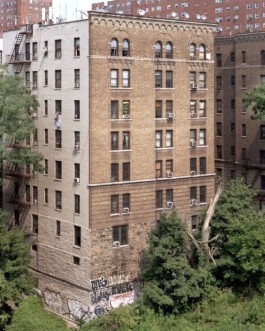
12
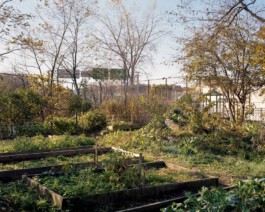
13

14

15

16
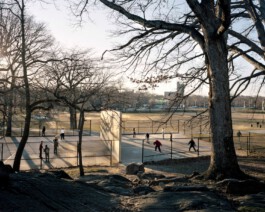
17
Images
1–17 Ira Wagner, Superior Apartments, New York City, New York (US) 2011–2013.
Info
Superior Apartments was shot in the Bronx from 2011 to 2013. The project was my MFA thesis for the University of Hartford’s Limited Residency program. For many people, the Bronx is synonymous with urban failure. I worked in the Bronx in the summer of 1977 and witnessed the declining neighborhoods and devastation that took place following the blackout that occurred that summer. As someone with a keen interest in urban history and development, as well as family history, I was interested in what the present-day Bronx was like. What I saw and photographed was something very different from the images of the Bronx from that earlier time. For this project, I used a view camera and a medium format camera. It was a wonderful experience to set up the view camera and get under the dark cloth on various street corners throughout the Bronx. People walking by were interested in what I was doing and I would let them take a look through the ground glass.
Links:
Interview

1
Ira Wagner (US),
Superior Apartments
New York City, New York (US)
(1) Please introduce yourself: What is your name, where are you from, what do you do?
I’m Ira Wagner and I live in Montclair, New Jersey about 12 miles west of New York. I worked in banking for many years but decided to stop in 2008 to pursue other interests, including photography. I couldn’t have imagined then that this would lead to me returning to school, and receiving my MFA degree in 2013. Following graduation, I began teaching photography at Monmouth University in New Jersey and I have been working on a number of projects, focused on the urban landscape and the built environment.
(2) What is your relationship with photography and how did you get into it?
Probably like many people, my relationship began when I was young. I delivered the newspaper, saved my 10 and 25 cent tips and bought a camera—a Minolta SRT 100. (It’s quite a workhorse—I still have it and have lent it to students when teaching black and white darkroom at Monmouth). Photography for me is partnered with a life-long interest in maps, travel, urban history, exploring new places and wandering around cities. I must admit, it never occurred to me to pursue photography professionally during my college days, but I think these interests overlapped even then—I studied urban history and planning in college. After leaving banking in 2008, I began to take courses at ICP in New York. Many of these courses had a strong impact on me, particularly on subject matter and developing an approach to photographing. Courses focused on the urban landscape opened up my eyes to a whole different world of landscape photography. I began shooting in and around New Jersey’s meadowlands (places I passed through while commuting to my job in NY) and the neighborhood I grew up in—Yonkers, NY. For some of my first work, I kept shooting in «golden hour,» until one of the ICP teachers said to stop doing that and to shoot in the bleakest, greyest light in the middle of the day. At ICP, I was also exposed to the use of the view camera. Finally, one of my teachers there suggested looking into an MFA, which led to where I am today.
(3) What do you think triggers you to photograph in a certain moment? Is it planned or solely driven by intuition?
Things start with intuition in trying to find the places and scenes that I am interested in and think will make a strong photograph. Then, there is an element of planning as I move into something that I am going to photograph more extensively. The planning includes time of day, type of light, weather and destination. Once in a place at the right time and with the right light, there is again intuition. I’ll generally walk extensively and come to subjects that are what I am looking for. There is always a sense of surprise and discovery in my wanderings, which is part of the pleasure I take in photographing. Also, while driving to my destination, I’ll be alert to places that look ripe for a return visit on a future day.
(4) What is the story you want your pictures to tell?
There are several themes that run through my work; in some projects one of the themes may be stronger than others. Generally, they involve how people choose to live and work. Additionally, I look for layering of history—thinking about the time the places I am photographing were built as well as what has happened since. What were the original designers and builders of a place seeking to communicate? Is the environment conducive to living for them and their families? What does the architecture of the area look like and what messages do their environments convey? How is the history of a place evident in what is there now and how has an environment changed and adapted over time? Why do people choose the place they live? Ultimately, underlying these themes is that there is a common goal for families across history and cultures—for a safe and comfortable place to live.
(5) Which city would you like to visit the most, and why?
I can find something of interest in almost any city I visit. I especially like to explore «everyday» neighborhoods – the places that people live, work, shop and play. I look to find what makes a place unique—the style of buildings, the history, the culture. Earlier this year I made my first visit to India. It was a rich visual environment that appealed to me in so many ways—the layers of history, the passion, energy and vibrancy of the people. One place I didn’t visit which I would like to photograph is Kolkata. It seems like a place with so many layers to explore and photograph. For a photography project, I like to have the opportunity to work in a place over time. As I explore a place, different themes and ideas manifest themselves that I can work on more deeply. Present day Kolkata also combines many things that I have been looking at more recently in the urban environment, including climate change and its effects on the urban and built environment.
(6) Regarding your project Superior Apartments: What was your intention, and how did you come up with the idea?
Superior Apartments combined many interests that I have in the city: the history of urban development, unique architecture, the ideas that have evolved over time for improving the city, and how people impact and are impacted by their environments. There was also the personal relationship I had with the Bronx. I was born there, had family living there through the early 70s, my mother taught school there through the 90s and I worked there in college. The Bronx is essentially a laboratory of urban development. The Grand Concourse (the «Champs Elysees of the Bronx») was built to be the pinnacle of middle class aspirations in the 1920s and 1930s with an explosion of art-deco apartment buildings. In the 1960s and 70s, the Bronx became a catchword for the ills affecting American cities. For many, that image of the Bronx has remained, even as the borough has rebounded and changed. In its history, the Bronx has had dramatic cycles of promise, possibility, loss and revival. In shooting this project, I was looking to capture the range, chaos, richness and beauty of the urban landscape.
(7) Which project did you never finish?
I have several projects that have moved into the background, but which I plan to return to. I have been photographing the Highline in New York City in black and white in a 6x17 format. I have also started a project that goes by the working title Acela, in which I have been photographing the landscape around the train line between New York and Washington. What I find is that I turn to a particular aspect of something that I start and focus in on that. While I have taken pictures in many places along the Amtrak route, including Baltimore and Chester, Pennsylvania, I have focused in for the time being on «twin houses» in Northeast Philadelphia.
(8) What is that «one thing» you have never managed to photograph and is now gone for good?
One of the first areas I explored was the area I grew up in. There are at least two institutions that I would have liked to photograph that are now gone. One is the local candy store—Lane’s Luncheonette. It was a classic New York institution—a lunch counter with stools where you could get an egg cream, racks of magazines and comic books, greeting cards, toys, a pay phone in the back. Everyone came there at some point during the day and they kept tabs which your parents could settle later. The other place that I was surprised to find was gone was the central Yonkers public library. It was one of the Carnegie sponsored libraries and was an inspirational building in the old downtown of the city that I spent hours in. I remember that they had a great collection of architecture monographs. More generally, the life I remember on the sidewalks of Yonkers doesn’t seem to exist there anymore.
(9) If you could travel back / forth in time, what advice would you give your younger / older self?
I would «enlighten» my younger self to the full range of photography and its tools. I would love to have been exposed much earlier to the view camera and all its capabilities.
(10) What do you prefer saying: To «take a photograph» or to «make a photograph», and why?
I still think of it in terms of taking a photograph—looking at the world and extracting something that is interesting to me and may be overlooked.
(11) What is the most interesting experience you have had while photographing?
I’ve had so many. Photography for me is exploration and discovery—finding something unexpected. I particularly like when I am photographing something and someone passing me by turns and looks at where my camera is aimed and tells me that although they pass the site almost every day, they never noticed what I see in the place.
(12) If it wasn’t for photography, what would you be interested in doing instead?
I spent many years already doing things other than photography. I certainly don’t have regrets, but I wouldn’t want to give up the role photography plays in my life today.
(13) How would you describe one of your pictures to a visually impaired person?
A series of 30 story apartment buildings in white and brown brick looms over an expanse of parched lawn making up the bottom third of the frame. The lawn is empty, except for a woman in bright blue sitting on the lawn near the front of the image gazing at the buildings. Her small daughter in pink is facing away, tossing her white sandal in the air. They are dwarfed by the scale of the buildings in the background. The sky is blue grey and filled with high clouds. How does she feel about the place she is living?
(14) What are you currently working on, and—if there is—what is your next project or journey?
In photographing the landscape between New York and Washington, I have come to concentrate on twin houses of Northeast Philadelphia (the neighborhood is also known as «The Great Northeast»). I have been fascinated by the sheer expanse of the landscape—block after block of twin houses with many variations of a basic design—two side by side houses that share a common center wall. Some are of brick, some of stone. The gables may be over individual windows, one side of the houses or the other. Because the structure is shared, they haven’t changed much since the time they were built. The small details are telling—sometimes one side of the lawn is mowed and the other is overgrown with weeds. Many people mark the division by a bush or tree. Some completely hide their side of the building with lush landscaping, others have their lawn chairs and grills out for everyone to see. I see many more trips to the area. I just returned from a vacation to the Adriatic. I loved photographing the architecture there—Trieste, Vicenza and Venice in Italy and Ljubljana in Slovenia. Trieste and Ljubljana have a rich heritage with a strong Austrian Secession influence. Ljubljana has these buildings alongside buildings constructed during the communist era. Vicenza is the home of Palladio who was instrumental in neoclassical architectural design in the 16th Century. Again, many layers of history to explore.
Thank you, Ira.

2

3

4

5

6

7

8

9

10

11

12

13

14

15

16

17
Images
1–17 Ira Wagner, Superior Apartments, New York City, New York (US) 2011–2013.
Info
Superior Apartments was shot in the Bronx from 2011 to 2013. The project was my MFA thesis for the University of Hartford’s Limited Residency program. For many people, the Bronx is synonymous with urban failure. I worked in the Bronx in the summer of 1977 and witnessed the declining neighborhoods and devastation that took place following the blackout that occurred that summer. As someone with a keen interest in urban history and development, as well as family history, I was interested in what the present-day Bronx was like. What I saw and photographed was something very different from the images of the Bronx from that earlier time. For this project, I used a view camera and a medium format camera. It was a wonderful experience to set up the view camera and get under the dark cloth on various street corners throughout the Bronx. People walking by were interested in what I was doing and I would let them take a look through the ground glass.
Links: